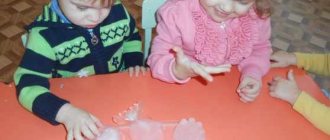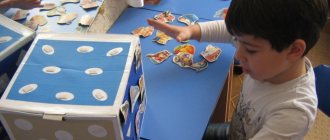Preparatory group
At this age, kindergarteners are preparing for school. They must have narration skills, tell from memory and visual material. It is important, with the help of games, to develop imagination, memory, spatial and color perception in future schoolchildren, to cultivate communication skills, a sense of beauty, the ability to build a dialogue, attentiveness, and perseverance.
What kind of flower are you?
Invite the students to “turn” into flowers. Each player chooses what kind of plant to become, but does not tell his comrades about it. Children take turns coming forward, depicting their flower using facial expressions and body movements, without uttering a word. The rest of the guys must guess what plant we are talking about.
Flower shop
For the game, prepare natural or artificial flowers. Children act as florists. The game is collective and teaches communication, teamwork, and organization.
The students make up a beautiful bouquet. Then they try to sell it to the teacher. At the same time, they must praise the bouquet, explain what plants were used, why they chose them, and for what purpose the flower arrangement is intended.
Flower names
The players form a circle. The teacher stands in the center, throws the ball to each child in turn, saying a name or an object named similar to a flower. The player who catches the ball must name the corresponding plant. For example: Vasily - cornflower, nail - carnation, Roman - chamomile, jug - water lily, Lilya - lily, Violetta - viola, toffee - iris. The player who finds it difficult to answer is eliminated from the circle.
Junior group
For younger preschoolers, simple educational, active and musical games are recommended.
Post a flower
Make two paper daisies for the game with the petals separated from the core. The number of petals must correspond to the number of players. Place daisies on the floor near the wall. Divide the students into 2 groups with an equal number of players.
Invite teams to move their daisy to the opposite wall. Each player transfers only one part of the plant: the first - the yellow core, the second - the petal, and so on. A player is not allowed to take two petals at once. The next participant starts moving when the previous one returns to the start. The team that collects its daisy first wins.
Collect a bouquet
Before playing, tell the children what parts flowers are made of: core, petals, stems and leaves. Cut out plant parts from colored paper and glue them into a bouquet arrangement, but do not glue the petals. Make petals of a certain color from the main spectrum for each flower. Tell the students that the wind tore off the petals, which now need to be selected according to the color for each plant in the bouquet.
Bells
Children choose a leader by lot. He leaves the room. The players hide a picture depicting a blooming bell in the game room, disassemble the musical instruments themselves - small bells, and distribute them throughout the room. Moreover, one of the players must stand close to the hidden image.
The presenter enters the playroom, begins to walk around it, and approaches the children. When he approaches a player who is standing far from the picture, he does not ring the bell. When he approaches a participant standing closer to the picture, he makes a quiet ringing sound. The leader approaches the target even closer - the player makes a louder sound. The participant closest to the others rings the loudest. This way the presenter understands where to go in searching for the picture.
A flower is blooming
The game is educational. First tell the children how flowers bloom in nature. Prepare plant templates and distribute to students. Show how to curl the petals. Let the children put the flowers in a glass of water and observe what happens to the petals. When exposed to moisture, the petals will begin to “bloom.”
Middle group
Older preschoolers should know where flowers grow, what features and properties different types of plants have. It is important to instill in students a love for the nature of their native land. We must not forget about the physical activity of the children.
Where does the flower grow
For the game, prepare pictures of flower beds, fields, forests. Make cards depicting flowers familiar to the children. Invite the players to distribute the cards according to the pictures of growing places.
Flower drawing competition
By participating in an art competition, children develop imagination, creative skills, and color perception.
For the competition, purchase or pick a large flower from your garden: tulip, peony, rose, sunflower, iris or other. Children prepare art supplies and sit at easels, if available, or tables. From the finished works they put together an exhibition and choose the winner of the competition whose work they liked the most.
Flowers
The didactic game “Flowers” develops speech skills, imaginative thinking, and the ability to select descriptive features.
Ask a question and let the children give descriptions. You cannot repeat yourself; for each correct answer the player receives a point. The participant with the most points wins.
Here are sample questions:
- What kind of rose? – beautiful, red, lush, fragrant, tender;
- What flowers have spines? – rose, rose hip, cactus, blackthorn, burdock;
- What flowers are perfume made from? – jasmine, lavender, rose, lily of the valley, peony;
- What plants are honey made from? – dandelion, linden, acacia, clover;
- What flowers are yellow? – sunflower, dandelion, narcissus, buttercup.
Flower catch-up
Each player chooses the name of the flower; they should not be repeated. The players decide by lot who is catching up. Let it be “Cornflower”. He names some other plant, for example, “Dandelion”. The player who chose the name “Dandelion” runs away. "Cornflower" catches up with him. When “Dandelion” feels like it is about to be overtaken, it may say out loud another flower, such as “Chamomile.” Then “Romashka” has to run away, “Cornflower” switches to her. If “Dandelion” does not have time to pronounce the word and is caught, then it becomes catching up.
Senior group
Games for older preschoolers should be aimed at developing logical thinking, speech, intelligence, curiosity, and perseverance. At this age, children must classify plants according to different characteristics, and preparation for school begins.
Turning into a flower
The game strengthens the facial muscles and promotes overall physical development.
Invite the students to use facial expressions and body movements to depict a flower, how it opens its petals, reaches out to the sunlight, bends its stem under the raindrops, and closes for the night.
Name the odd one out
For the game, prepare groups of cards: meadow species, forest, field, garden, water. There are 4 plants in each group, one of them does not correspond to the category. Lay out the cards in front of the players, ask them to name the extra type and explain their opinion.
For example: rose, tulip, clover, peony. Clover is not a garden plant, but a meadow plant.
Flowers
In addition to getting to know plants, the goal of the didactic game “Flowers” is physical training, developing dexterity and a sense of rhythm.
The children take turns playing. The player takes the ball, hits it on the floor or wall, catches it, and names a plant with each hit. He must name 5 species. You can't repeat yourself. If a player cannot remember the plant, then he gives the ball and the right to play to the next player.
Name the adjective
The game develops the skill of forming adjectives from nouns. Name the flower and the object. The player must name an adjective that is a qualitative attribute of this object:
- poppy, and the grain... poppy;
- chamomile, and the field... chamomile;
- a rose, and the bud... pink;
- acacia, and honey... acacia;
- cornflower, and the eyes... cornflower blue;
- dandelion, and the jam... dandelion.
Didactic games for preschoolers.
Teacher of MBDOU No. 39
Nikishina Z.N.
So the summer has flown by. It was blooming. After all, it is in the summer that flowers bloom the most - in gardens, in parks, in the forest outside the city... Children love to admire flowers and collect them in bouquets. Do our children know the name of flowers well, do they know when and where they bloom? We offer a selection of games that will help preschoolers better remember the names of flowers and their characteristics, teach them to write coherent stories and expand their imagination and visual attention.
Didactic game for children of senior preschool age “Collect a flower.”
Goal: to generalize children’s knowledge about the components of plants, to practice the use of nouns in the genitive case, singular and plural, to develop visual attention and memory.
Materials: cards with images of stems and leaves, cards with flower heads.
Progress of the game:
Option 1. The teacher gives the children cards with pictures of stems and leaves. The children are shown a card with images of flower heads of different plants.
Educator. The green leaves will come to life,
And they will find their flower.
The child who has an image of the leaves and stem for this flower replies: “I recognized you, chamomile, you are my stem.” The child receives a card and makes a flower.
Option 2. The teacher has stems and leaves, the children have flowers.
Educator. Flower, flower, will come to life and find its leaf!
Child. I recognized you, you. You are the leaves of my bell.
As the game progresses, the teacher can ask the children questions: “What else do you know about chamomile? Where does she like to grow? When does it bloom? Does chamomile have any special characteristics? Compare chamomile and bellflower based on similar characteristics. What is the difference between chamomile and poppy?” etc.
Didactic game for older preschoolers “Let's plant flowers in a flowerbed.”
Goal: to summarize children’s knowledge about the season, flowering time and place of growth of flowers, to train in writing descriptive stories: to develop coherent speech, visual attention, and memory. Cultivate a caring attitude towards plants.
Equipment: Large cardboard cards with the image of bouquets of flowers, small cards with the image of one flower for creating a flower bed.
Progress of the game
Educator. Each of us enjoys admiring the beautiful flowers that grow in the flowerbeds of our city. Do you think it’s possible to tear them and collect them into bouquets? (Children's answers)
— Of course, you don’t need to collect flowers in bouquets, but you can “plant” them in a flowerbed. Cards are laid out in front of you, depicting wildflowers (garden flowers, primroses). Find an image of the flowers you have chosen on the small cards and “plant” them in the flowerbed. (Children's work)
- Well done, what beautiful flowers bloomed in your flower beds. And now, without naming the flower itself, tell us everything about it (when it blooms, where it likes to grow, what color).
Didactic game for older preschoolers “Grow, flower, blossom.”
Goal: to expand children’s knowledge about the process of plant development; practice composing coherent stories with establishing cause-and-effect relationships; develop visual attention (analysis, synthesis, comparison).
Equipment: cardboard circle divided into 8 segments, 8 different segments depicting different stages of plant development.
Progress of the game
Educator: Guys, in order for a flower to grow, you must first plant a small seed in the ground, take care of it, when the sprout appears, weed out the weeds. This is how to grow garden flowers. However, in the meadow, in the forest, in the field, many different flowers grow, although no one planted or cared for them. Nature itself took care of them. The wind brought a seed, the rain watered it, the sun caressed it - and a beautiful flower grew
- Now guess the riddle.
Yellow sisters bloomed in the grass.
They turned gray and flew with the wind.
They will fall to the ground and bloom again. (Dandelion)
— Did you find out what flower the riddle is about? (Children's answer) That's right, it's a dandelion. Now please tell me how this flower grows. And these pictures will help you. Look at them carefully: each card depicts a certain stage of plant development, starting from the seed. Lay out these pictures in a circle, clockwise in the correct sequence.
Children independently make a circle from the segments, and each one talks about “their” stage of plant development
During the game, the teacher helps the students with leading questions, to which the children must give a detailed answer, for example: “What does a seed need to germinate?” (To germinate a seed you need: water, heat and light). What leaf shape is this plant? (Holly plants).What color is the flower? Show the stem, leaves, bud, blooming flower. Why did the dandelion fly away? (The dandelion scattered because the wind blew. The wind will blow the seeds away, and they will fall to the ground and new dandelions will soon grow).
Educational didactic game “Computer Make-Believe”.
Purpose: to generalize knowledge about the main parts of the plant, the conditions necessary for the growth and development of the plant; develop visual perception, attention, memory, thinking, imagination, expand the understanding of the surrounding world and human interaction with nature.
Equipment: homemade toy computer, floppy disks with tasks, cubes depicting subject pictures.
Progress of the game
Educator. Lay out the cubes with pictures, complete the task on the floppy disk.
1. Conditions necessary for the growth and development of a plant (soil, water, light, heat).
2. The main parts of the plant (root, stem, leaf, flower).
An outdoor game for older preschoolers “Visiting the Flowers.”
Goal: to develop auditory attention, imagination, expressiveness of movements and facial expressions, to cultivate interest in the plant world.
Equipment: hats (chamomile, violet, poppy, bell), audio recording of Tchaikovsky’s “Waltz of the Flowers” from the ballet “The Nutcracker”.
Preliminary work: observing flower beds, learning the names of flowers, reading poems about flowers, asking riddles, singing songs.
Progress of the game
Tchaikovsky's "Waltz of the Flowers" is playing quietly in the group
Educator. Guys, now you choose your hats of colors and squat down on the rug. I will read a story about flowers, when someone hears that it is about his flower, he must stand up and perform the movements according to the text.
— Morning came and the sun woke up. I went out onto the porch and breathed in the fresh air filled with the scent of flowers. I wanted to go and say hello to the flowers. I headed down the path, and soon
I saw a chamomile in the grass. (Child - daisy gets up) She just woke up and opened her eyes (the child performs the action). Seeing me, she nodded her head back and forth several times (corresponding to
general movement), spread the petals in the wind (the child spreads his arms to the sides) and waved to me (the child makes several waves with his arms). Perhaps the flower said hello to me. And a little further I saw a blue bell, which stretched its head towards the sun. (The child performs the movement.) Then a breeze blew, and the flowers began to sway: back and forth, back and forth. (Children perform the movements)
The sun came out even stronger, and other flowers woke up. (Children perform the movements). They rejoiced in the sun and nodded their beautiful heads. Suddenly a cloud flew in, a warm summer rain began to fall, and the flowers began to catch the raindrops with their petals.
During the teacher's story, the flower children grow and open their buds, wither under the rays of the scorching sun and happily catch raindrops with their petals. Then the narrator returns home and walks out of the garden, where she is greeted by garden flowers. At the end of the game, the teacher “collects a bouquet of flowers” - everyone joins hands and dances to cheerful music.
Related materials:
- Didactic games for preschoolers “Emergencies”, “Be careful!”
- Didactic game for middle preschool children “Dangerous objects”
- Didactic game for children of senior preschool age “Object world of Rescue Service 01”
- Didactic safety game for older preschoolers “Home Alone”
- Didactic games for preschoolers “Good and Evil Fire” and “Rescue Service”
Newer articles:
- When and how to teach a child to read
- English private kindergarten CIS International School in Moscow
- Spiritual and moral education of preschool children
- Synopsis: “Dunno visiting the guys”
- GCD summary: “houseplants”
Older articles:
- Abstract of the educational activity for the implementation of the educational field “Safety” for students of the senior general education group “Science for Dunno”.
- Physical education lessons for preschoolers.
- Direct educational activities for the senior group on moral education “Mom is the sun in the family, and we are its rays.”
- Summary of an open lesson on speech development in the junior group on the topic: “Vegetables and Fruits.”
- Summary of a walk in the preparatory group of the “Wonders of the Wind” kindergarten.









